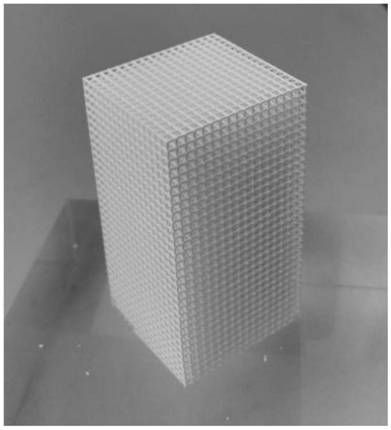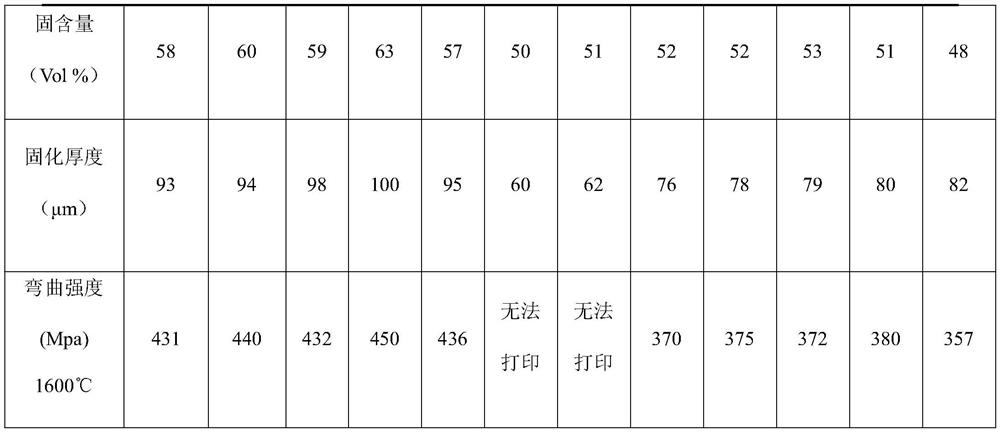Aluminum oxide ceramic slurry for photocuring 3D printing, preparation method and aluminum oxide ceramic
An alumina ceramic, 3D printing technology, applied in the direction of additive processing, can solve the problems of low solid phase content, poor curing and molding accuracy, low mechanical properties of products, etc., to improve affinity, reduce curing shrinkage, and improve The effect of density
- Summary
- Abstract
- Description
- Claims
- Application Information
AI Technical Summary
Problems solved by technology
Method used
Image
Examples
Embodiment 1
[0029] Step 1: Pretreatment of alumina powder, first dissolve dispersant BYK111 (2.5wt% of alumina mass) in absolute ethanol, then mix with alumina powder (20wt% of 40nm and 80wt% of 2μm) for 5h , and then dry the slurry at 50°C and pass through a 60-mesh sieve, wherein the mass ratio of alumina powder to ethanol is 1:2.5;
[0030] Step 2: Slurry preparation, the alumina powder pretreated in step 1, resin monomer (isobornyl methacrylate, propoxylated neopentyl glycol diacrylate, tri(propoxy) triacrylate The mass ratio of the mixture is 2.5:5:1.5), (2,4,6-trimethylbenzoyl) diphenylphosphine oxide, diluent polyethylene glycol 200 mixed ball mill and vacuum pumped for 0.5h to obtain Alumina ceramic slurry; wherein the volume ratio of alumina powder: resin monomer: diluent = 58:32:10; the initiator is 1.5% of the mass of the monomer, the ball milling medium is spherical alumina of 2 mm, the material-ball ratio 1:2, ball mill speed 300r / min, ball milling time 2h.
[0031] Adopt D...
Embodiment 2
[0033] Step 1: Pretreatment of alumina powder, first dissolve the dispersant BYK111 (1wt% of alumina mass) in absolute ethanol, then mix with alumina powder (20wt% of 40nm and 80wt% of 2μm) for 5h, Then dry the slurry at 50°C and pass through a 60-mesh sieve, wherein the mass ratio of alumina powder to ethanol is 1:2.5;
[0034]Step 2: Slurry preparation, the alumina powder pretreated in step 1, resin monomer (isobornyl methacrylate, propoxylated neopentyl glycol diacrylate, tri(propoxy) triacrylate The mass ratio of the mixture is 2.5:5:1.5), (2,4,6-trimethylbenzoyl) diphenylphosphine oxide, diluent polyethylene glycol 200 mixed ball mill and vacuum pumped for 0.5h to obtain Alumina ceramic slurry; wherein the volume ratio of alumina powder: resin monomer: diluent = 58:32:10; the initiator is 1.5% of the mass of the monomer, the ball milling medium is spherical alumina of 2 mm, the material-ball ratio 1:2, ball mill speed 300r / min, ball milling time 2h.
Embodiment 3
[0036] Step 1: Pretreatment of alumina powder, first dissolve the dispersant BYK180 (3wt% of alumina mass) in absolute ethanol, then mix with alumina powder (20wt% of 40nm and 80wt% of 2μm) for 5h, Then dry the slurry at 50°C and pass through a 60-mesh sieve, wherein the mass ratio of alumina powder to ethanol is 1:2.5;
[0037] Step 2: Slurry preparation, the alumina powder pretreated in step 1, resin monomer (isobornyl methacrylate, propoxylated neopentyl glycol diacrylate, tri(propoxy) triacrylate The mass ratio of the mixture is 2.5:5:1.5), (2,4,6-trimethylbenzoyl) diphenylphosphine oxide, diluent polyethylene glycol 200 mixed ball mill and vacuum pumped for 0.5h to obtain Alumina ceramic slurry; wherein the volume ratio of alumina powder: resin monomer: diluent = 58:32:10; the initiator is 1.5% of the mass of the monomer, the ball milling medium is spherical alumina of 2 mm, the material-ball ratio 1:2, ball mill speed 300r / min, ball milling time 2h.
PUM
 Login to View More
Login to View More Abstract
Description
Claims
Application Information
 Login to View More
Login to View More - R&D Engineer
- R&D Manager
- IP Professional
- Industry Leading Data Capabilities
- Powerful AI technology
- Patent DNA Extraction
Browse by: Latest US Patents, China's latest patents, Technical Efficacy Thesaurus, Application Domain, Technology Topic, Popular Technical Reports.
© 2024 PatSnap. All rights reserved.Legal|Privacy policy|Modern Slavery Act Transparency Statement|Sitemap|About US| Contact US: help@patsnap.com










